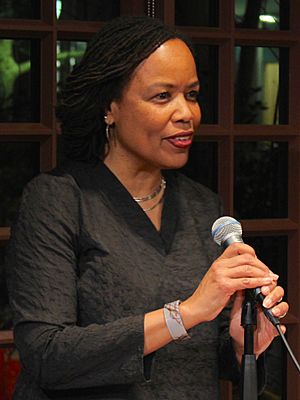Saidiya Hartman facts for kids
Quick facts for kids
Saidiya Hartman
|
|
|---|---|

Hartman in 2020
|
|
| Born | 1961 (age 63–64) |
| Education | Wesleyan University (BA) Yale University (PhD) |
| Occupation | Writer, academic |
| Known for | Critical fabulation |
|
Notable work
|
|
| Awards | MacArthur Fellow |
Saidiya Hartman (born 1961) is an American writer and professor who studies African-American history and culture. She teaches at Columbia University and is known for her important work on the history of slavery and its lasting effects. Her writing often explores stories from the past that have been forgotten or ignored.
Contents
Early Life and Education
Saidiya Hartman was born in 1961 and grew up in Brooklyn, New York. For her higher education, she attended Wesleyan University and later earned a Ph.D. from Yale University.
Career as a Professor and Writer
Hartman began her teaching career at the University of California, Berkeley, where she worked from 1992 to 2006. In 2007, she became a professor at Columbia University, where she specializes in African-American literature and history. In 2020, she was given the title of University Professor, one of the highest honors for a professor at Columbia.
Throughout her career, Hartman has received many awards for her work. She won a MacArthur Fellowship in 2019, which is often called a "genius grant." She has also been honored by the American Academy of Arts and Sciences and the Royal Society of Literature in the United Kingdom.
Hartman's Big Ideas
Hartman is famous for developing new ways to think and write about history, especially the history of enslaved people. Her work helps people understand difficult parts of the past.
What is Critical Fabulation?
Hartman created a unique writing method called critical fabulation. This is a way of telling stories from history when there are gaps in the official records.
Many historical documents, especially from the time of slavery, do not include the voices or experiences of enslaved people, particularly women. Critical fabulation uses the facts that are available and combines them with careful, imaginative storytelling to fill in the blanks. It helps to tell "an impossible story" that was almost lost to history. This method respects the past while giving a voice to those who were silenced.
The Afterlife of Slavery
Hartman also developed the idea of the "afterlife of slavery." This concept explains how the end of slavery did not end its impact on society. She argues that the effects of slavery can still be seen today.
For example, she points to challenges that many Black communities face, such as "limited access to health and education, premature death, incarceration, and impoverishment." This idea helps show how history continues to shape the present.
Important Books by Saidiya Hartman
Hartman has written several influential books that explore her ideas about history, memory, and the legacy of slavery.
Scenes of Subjection (1997)
Her first book, Scenes of Subjection: Terror, Slavery, and Self-Making in Nineteenth-Century America, looks at life during and after slavery in the 1800s. Hartman studied diaries, legal papers, and songs to understand how enslaved people created their own identities despite living in a brutal system.
Lose Your Mother (2007)
In her second book, Lose Your Mother: A Journey Along the Atlantic Slave Route, Hartman writes about her own journey to Ghana in West Africa. She followed the path of the Atlantic slave trade to explore the connection between Africans and African Americans. The book is a powerful look at memory and what it means to be disconnected from one's past.
Wayward Lives, Beautiful Experiments (2019)
This book tells the stories of young Black women living in cities like Harlem and Philadelphia around the year 1900. Hartman researched the lives of these women who were trying to create new, freer ways of living.
She shows how these women resisted the strict rules of society and found freedom in their own "beautiful experiments." The book was a huge success and won the 2019 National Book Critics Circle Award. In 2024, The New York Times named it one of the 100 best books of the 21st century.
Published Works
- Wayward Lives, Beautiful Experiments: Intimate Histories of Riotous Black Girls, Troublesome Women, and Queer Radicals (2019)
- Lose Your Mother: A Journey Along the Atlantic Slave Route (2007)
- Scenes of Subjection: Terror, Slavery, and Self-Making in Nineteenth-Century America (1997)
See also
 In Spanish: Saidiya Hartman para niños
In Spanish: Saidiya Hartman para niños

